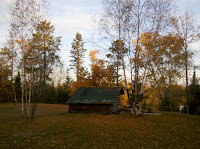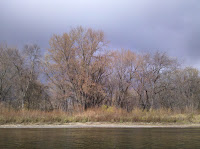Paddling the upper Mississippi River from Lake Bemidji to Minneapolis has been a paddlers's dream and I cannot understand that this 400 mile trip is not more popular. The scenery is gorgeous, the logistics relatively easy and the paddling even suitable for beginners. I can only highly recommend this trip to any paddler. Here are some tips on how to plan this trip and what to expect:
 |
| Mississippi at Lake Itasca |
What is the river like? The river starts out almost as a trickle at the source in Lake Itasca and although it is a very scenic area I would recommend starting a bit later at Lake Bemidji from where on the Mississippi is at least several metres wide. As it winds down its way through Minnesota it passes several small and big lakes and becomes wider and wider with plenty of islands and side channels. By the time it enters Minneapolis it is over 200 metres wide. But no matter where on this stretch the Mississippi feels very remote. You might hear the horn of a train or the white noise of a highway in the distance but out on the river you feel like in the wilderness. Keep in mind that the Mississippi up in Minnesota has nothing to do with your image of the Tom Sawyer river. On its first 400 miles it has a very Scandinavian feeling about it and is not yet the mighty brown and lazy river that Mark Twain described. The water is incredibly clear and wildlife is abundant. You will see hundreds of bald eagles that are almost extinct anywhere else in the US. There are plenty of beavers, otters and deer. And although there is a lot of farmland along the Mississippi you will not see much of it from the river.

How difficult is it? In a normal year paddling the Mississippi in Minnesota is very easy and suitable even for beginners. You might encounter some class I rapids but nothing serious. In a normal water level year the only problem are the big lakes, especially Lake Winnie. It is the third biggest lake in Minnesota and in bad weather the waves have killed several paddlers and even fishermen in motorboats. Don't cross the lake but stay along the shore. The DNR even recommends shuttling around the lake but unfortunately there is no commercial shuttle service. You will face a difficult hitch if you decide to portage around.
In a low water year things become more difficult and in the record drought year we paddled in some stretches of the river become outright difficult with shallow rapids almost every mile. Although not life threatening getting in and out of the boat to walk through or around them is very time consuming and annoying. And in a foldable kayak you always run the risk of getting a hole when hitting a rock. But I want to emphasize that the conditions we encountered were very unusual and paddlers should normally have a very smooth run.
 |
| Fall colors |
What maps do you need? You can download the maps for the whole stretch from the
DNR website. The maps are great and you won't need any other maps. They even give you some background information on each segment.
What is the best time to go? We started our trip 29th of September and this was definitely too late in the year. I would still recommend paddling in fall because of two reasons: There are very little or no bugs in fall and the fall colors are absolutely spectacular. I recommend starting in the first half of September.
How long will it take? It took us 3 weeks and one day to get from Lake Bemidji to downtown Minneapolis including one full and one half rest day. Keep in mind that we had to deal with relatively little daylight and low water issues. Other paddlers have done the same stretch in 16 days, but I would still suggest to plan for 3 weeks.
 |
| Power company dam |
Are there a lot of portages? Altogether there are around 10 portages. This does not sound like much, but the portages are generally pretty horrible. Only at Grand Rapids the power company offers a free motorized 24/7 shuttle service. You will find the telephone number posted next to the take out place and you can use the phone at the adjacent ranger station during office hours. The shuttle service will come within half an hour with a pick up truck and a canoe trailer for 6 canoes. On all the other portages you are on your own and it is definitely worth bringing a cart. The portages are up to 700 metres long and some involve some pretty steep ascents and descents. At Sartell you face three portages within 6 miles with the first one being down an almost impossible steep slope. If you have a foldable kayak you can avoid the three portages by using the Orange Cab van service. The approximate cab fare from Sartell dam to St. Cloud Dam will be 15$.
 |
| DNR campsite |
Where can you camp? The camping options are great! The DNR has created designated camp sites all along the river. These campsites are rather primitive and only provide a small flat camping area, a bench and table, a fire ring and a pit toilet. Although we liked those campsites they had one big disadvantage: Due to erosion they are usually very difficult to access. After some mud battles we resigned ourselves to free camping which was usually very easy and we found some very scenic camping spots. You will find very few houses on the shore and usually your only reminder of civilization will be the train horns in the distance.
Where can you resupply? Starting at Bemidji our first resupply stop was Grand Rapids. There is an official campground at the put out portage place but it is directly next to a busy highway and railway line and also far away from downtown and supermarkets. We camped at the put in place which was probably illegal and next to a residential area. If you put in there and paddle for only a couple of 100 metres you will find some good camping on the river banks. From the put in place it is only a 10 minute walk into downtown and a fantastic cheap AYCE Chinese buffet. The supermarket is about 10 minutes further.
Our next resupply stop was Aitkin which is the perfect town stop for paddlers. There is a nice free campground right on the river within walking distance of Aitkin. Within 20 minutes you can get to the great Roadside diner or fastfood places. A bit out of town you will find the laundromat with a hotel and showers opposite. Unfortunately the supermarket is outside town and it will take you more than half an hour walking to get there.
Our next resupply was Sartell where the Coburn supermarket is only one block from the river. Although there is no official dock, it is possible to beach there and walk over to the supermarket.
Monticello has a nice public park with a picknick shelter and public toilets next to the boat access and a big drugsture is right next to the park.
 |
| Lake Bemidji |
How do I get there and back? Logistics are actually not too difficult or expensive and it is definitely feasible to come over from Europe for this paddling adventure. At the time of writing the cheapest way to get here from Germany was to fly with Iceland Air which flies directly to Minneapolis from Rejkjavik. The one-way flight from Berlin to Minneapolis cost me 440 EUR. In Minneapolis rent a car and drive up to Lake Bemidji. Definitely book the rental car in Germany which is only half the price you would pay in the US. The 2 day one way rental with Hertz cost me 90$. It will take you almost the whole day to drive up to Lake Bemidji, especially if you make the side trip to Lake Itasca. In Bemdiji stay in the campground in Lake Bemidji State Park which is just within the 15 minute drop off service offered by Hertz. The campground is located on the lake shore and from some campsites it is just 200 metres to the water.
You can paddle right through downtown Minneapolis. We took our kayaks out at Boom Island Park boat access which is a nice park with toilets and shelters right in the centre of Minneapolis.

 Our bad luck continued next morning: As we were slowly packing up a double barge approached - and that meant at least a two hour wait - which is a big problem with only 9 hours of day light. We decided to at least paddle up to the lock and wait in the warmth. But how would we get around the barge? As the barge was stationary we just paddled around it - and roused the anger of both the captain and the lockmaster. Barges have very little control sideways and sneaking through between a parked barge and a levy wall is dangerous. First the barge crew yelled at us but then signaled us to go ahead. Then the lock master yelled at us. We confessed that we were amateurs and were forgiven after a safety sermon and the barge captain even allowed us to be locked through first.
Our bad luck continued next morning: As we were slowly packing up a double barge approached - and that meant at least a two hour wait - which is a big problem with only 9 hours of day light. We decided to at least paddle up to the lock and wait in the warmth. But how would we get around the barge? As the barge was stationary we just paddled around it - and roused the anger of both the captain and the lockmaster. Barges have very little control sideways and sneaking through between a parked barge and a levy wall is dangerous. First the barge crew yelled at us but then signaled us to go ahead. Then the lock master yelled at us. We confessed that we were amateurs and were forgiven after a safety sermon and the barge captain even allowed us to be locked through first. 




































